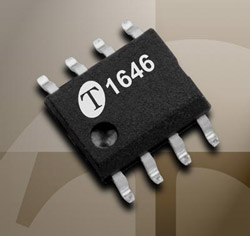THAT Introduces OutSmarts™ — the Smarter Balanced Output Driver IC

Milford, MA – THAT Corporation today announced that it is now sampling the 1600 series, a family of improved active-balanced floating-output driver ICs intended for use in pro audio applications. Compared to competing integrated solutions, the 1600 series offers at least 3dB more dynamic range and improves signal quality under demanding output-drive conditions. The series has fixed +6dB gain, and drives 600-ohm outputs to +27.5dBm, allowing them to drive long cables and difficult loads with ease.
The 1600 family uses THAT’s patented OutSmarts™ technology, a dual-feedback-loop design that prevents the excessive ground currents that flow in traditional cross-coupled output stages when clipping into single-ended loads. THAT Chief Technical Officer Gary Hebert explained: “Electronically balanced output drivers that mimic the ‘floating’ aspect of transformers have been used for years. The common circuits work fine – until they’re clipped into a single-ended load. When the driven output clips, the grounded output current-limits. This causes large, ugly current spikes to flow in the grounded conductor. These spikes return to the power supply through an indeterminate path, and in the process, they can upset the driven channel as well as adjacent channels in the same device, leading to audible distortion even in unclipped channels. Our patented design uses two control loops, one for the differential and one for common-mode signals, to eliminate this behavior.”
THAT’s president, Les Tyler, commented: “We’re very pleased that we can now offer output drivers that complement our extensive line of pro-audio input ICs, including our InGenius® balanced line receivers. The 1600-series completes the family, allowing us to cover all pro-audio analog connections from microphones to line inputs and now outputs. Like our input family line, the 1600-series is made in our own fab in Silicon Valley and takes advantage of our advanced dielectric-isolation semiconductor process.”
These parts are available in two basic versions. The 1646 comes in 8-pin DIP, 8-pin SO and 16-pin-wide SO packages, making it pin-compatible with the Analog Devices SSM2142 and Texas Instruments’ DRV134 and DRV135. Tyler pointed out: “The proprietary-pinout 1606 offers two advantages for new designs. First, it offers a differential input, which increases flexibility in connecting to the differential outputs of today’s D/A converters. Second, the 1606 requires only one small (0.1uf) capacitor plus one resistor to minimize common-mode dc at the outputs. This saves board space compared to the pair of 10-uF electrolytic capacitors required by existing ICs.” The 1606 is available in a space-saving 16-pin QSOP package. A 14-pin DIP version will be available for evaluation.
The family runs from ±18V to ±4V supplies, drawing only 4.5mA at ±18V rails. For the entire family, THD is .0007%, noise floor is -101dBu (unweighted, 20Hz~20kHz), slew rate is 15V/µs, and bandwidth is >10MHz. Samples are available now.
About THAT Corporation
THAT Corporation, founded in 1989, designs and sells high-performance analog integrated circuits for professional audio manufacturers. THAT’s ICs include analog input and output stages, digitally controlled low-noise preamplifiers, Analog Engines® and its original line of voltage-controlled amplifiers (VCAs) – all used throughout the pro audio industry. The company also licenses patents, trademarks, and other intellectual property to the TV broadcast and reception industries. Licensed products include the dbx-tv® Total™ series of audio enhancement technology and digital implementations of legacy TV audio receiver standards. The company is headquartered in Milford, Massachusetts, with offices in Milpitas, California.
For more information, contact:
THAT Corporation, 45 Sumner Street, Milford, MA 01757-1656 , USA
Telephone: +1 (508) 478-9200; Fax +1 (508) 478-0990
Email: More Information
Editorial Contact:
Ken Nevard, IC Marketing Manager
Tel: +1 (508) 478-9200 x108
Email: Editorial Contact